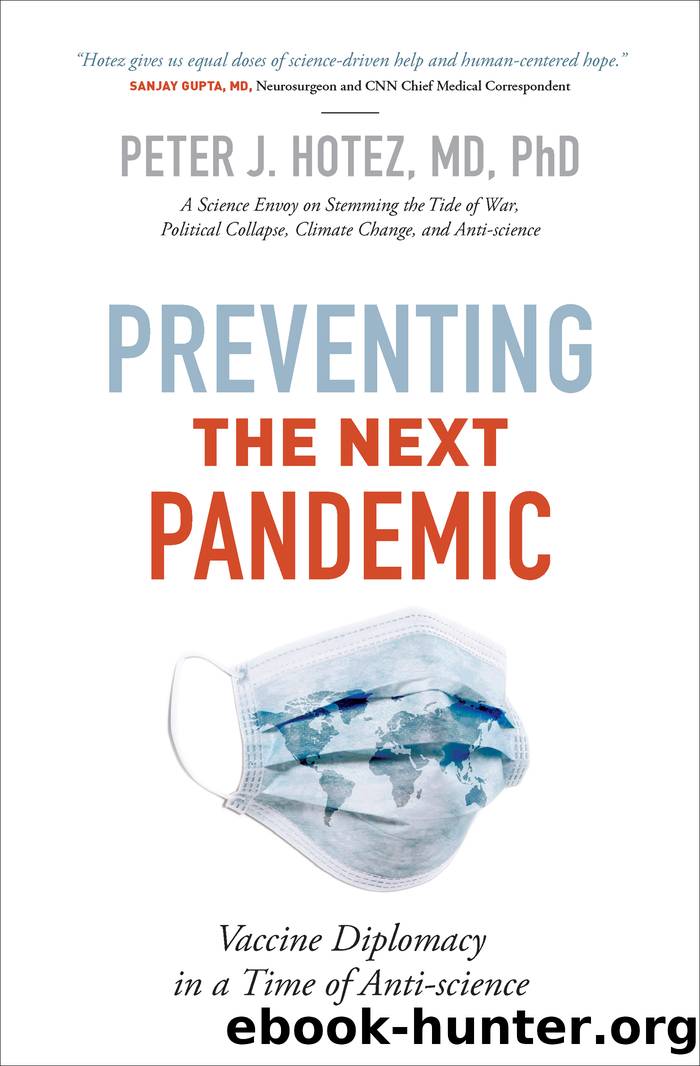Preventing the Next Pandemic by Peter J. Hotez

Author:Peter J. Hotez
Language: eng
Format: epub
Publisher: er
Published: 2020-03-15T00:00:00+00:00
Halt in Vaccination, Internal Displacement, and Exodus: Vaccine-Preventable Diseases
Among the first illnesses to return with the collapses of regimes in the Middle East and Africa are the vaccine-preventable diseases, and the same is true for Venezuela. In collaboration with Alberto Paniz-Mondolfi at the Venezuelan Institute of Biomedical Research in Barquisimeto, and other Venezuelan and international investigators, I reported on the resurgence of vaccine-preventable diseases [3]. Measles is the first to return because of its high reproduction number, in part owing to its hardiness, which allows it to linger in the atmosphere or on inert surfaces. As the Venezuelan economy began to unravel, so did its health systems and epidemiologic surveillance systems for monitoring vaccines. Beginning in 2010, there were increasing numbers of interruptions in national vaccine programs, together with piecemeal collapses in Venezuelaâs primary healthcare system [3]. Vaccinations began to decline precipitously. Beyond the lapses in vaccination programs, Venezuelaâs mining camps, many of which were illegal, became venues for internally displaced unvaccinated workers to cluster and ignite additional measles outbreaks. Internally displaced populations came into contact with Venezuelaâs indigenous populations, such as the Yanomami, or in some cases the indigenous workers themselves began working in the mines. Tragically, the Yanomami and other indigenous people were highly susceptible to measles, much as Native North Americans were when they first experienced contact with European explorers beginning hundreds of years ago.
The results were predictable. Even though measles was once eliminated from Venezuela, it reemerged in 2017. By the end of 2018, there were more than 8,000 new measles cases in Latin America, with two-thirds in Venezuela [3]. At least 80 people died from the disease. Based on examination of the specific genome of the measles virus, the overwhelming number of Latin Americaâs cases either occurred in Venezuela or were a direct result of spread from refugees fleeing Venezuela to neighboring Brazil, Colombia, and other South American countries [3]. In Brazil, the two states bordering VenezuelaâAmazonas and Roraimaâwere the most affected. Diphtheria, another serious and potentially deadly vaccine-preventable disease, has also emerged in the mining camps and is spreading into other areas of Venezuela and neighboring Brazil [3]. There are further concerns that polio could resurface in these areas, and now weâre seeing the emergence of COVID-19.
In September 2018, the UN Human Rights Council proposed and adopted a resolution on Venezuelaâs humanitarian crisis, which included the urgency of addressing the rise in vaccine-preventable diseases and underlying malnutrition [3]. Around that time, I made a site visit to La Guajira, a peninsula on the northern coast of Colombia, located next to its eastern border with Venezuela. La Guajira is a highly arid and impoverished region that is host to several indigenous peoples, including the Wayuu, a group famous for their historic resistance to colonization and conquest by the Spanish. Today, many of the Wayuu live in profound poverty and suffer from high rates of malnutrition, owing in part to the difficulties of growing produce in such a dry environment. Texas Childrenâs Hospital and Baylor College
Download
This site does not store any files on its server. We only index and link to content provided by other sites. Please contact the content providers to delete copyright contents if any and email us, we'll remove relevant links or contents immediately.
| Administration & Medicine Economics | Allied Health Professions |
| Basic Sciences | Dentistry |
| History | Medical Informatics |
| Medicine | Nursing |
| Pharmacology | Psychology |
| Research | Veterinary Medicine |
Periodization Training for Sports by Tudor Bompa(8102)
Why We Sleep: Unlocking the Power of Sleep and Dreams by Matthew Walker(6563)
Paper Towns by Green John(5030)
The Immortal Life of Henrietta Lacks by Rebecca Skloot(4453)
The Sports Rules Book by Human Kinetics(4221)
Dynamic Alignment Through Imagery by Eric Franklin(4055)
ACSM's Complete Guide to Fitness & Health by ACSM(3942)
Kaplan MCAT Organic Chemistry Review: Created for MCAT 2015 (Kaplan Test Prep) by Kaplan(3911)
Introduction to Kinesiology by Shirl J. Hoffman(3699)
Livewired by David Eagleman(3626)
The River of Consciousness by Oliver Sacks(3502)
The Death of the Heart by Elizabeth Bowen(3492)
Alchemy and Alchemists by C. J. S. Thompson(3426)
Bad Pharma by Ben Goldacre(3213)
Descartes' Error by Antonio Damasio(3194)
The Emperor of All Maladies: A Biography of Cancer by Siddhartha Mukherjee(3027)
The Gene: An Intimate History by Siddhartha Mukherjee(3014)
The Fate of Rome: Climate, Disease, and the End of an Empire (The Princeton History of the Ancient World) by Kyle Harper(2976)
Kaplan MCAT Behavioral Sciences Review: Created for MCAT 2015 (Kaplan Test Prep) by Kaplan(2909)
